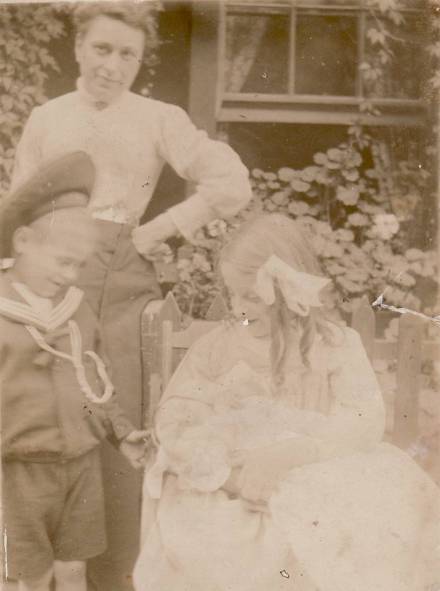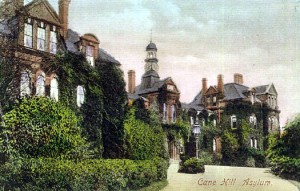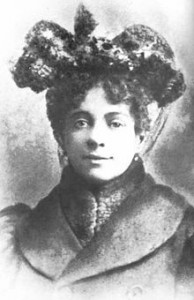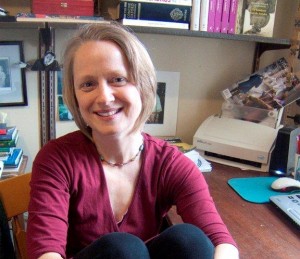
“. . . little by little, the ghosts take shape.”
My sister Tracy Kasaboski and I wrote a book together called The Occupied Garden, about our father’s family in Holland during the Second World War and their subsequent move to Canada. Being a collaboration and a work of non-fiction, the book seemed a bit of a departure for me. I’ve written four novels and feel most comfortable making up stories; the weight of responsibility is huge when reviving a true story whose characters are family members, even when they’re no longer living.
And yet, as our project moved along, I realized it was not as great a departure as I’d imagined. Like my novels, it was a story about “family” in the universal sense, and the connections between husband, wife, mother, father, child, and sibling.
Five years have passed since The Occupied Garden was published, and Tracy and I have embarked on a companion book, this time about our mother’s family in some of the poorest neighbourhoods of First World War London, England. Because we don’t speak Dutch, the biggest hurdle with The Occupied Garden was language; the greatest challenge with this new book is that we’ve dipped further back in time.
There are no longer living family members to give us those personal details that make a memoir come alive. Our grandmother Dory died in the 1990s. Orphaned as a young girl, she remembered very little of her parents. So reconstructing her childhood is detective work, in a way, and painstaking. Sometimes it’s even tedious. But it’s also immensely gratifying when the snooping yields results: little by little, the ghosts take shape.

Dory’s father died when she was a baby, and when Dory was 7, her mother Mary Ann was diagnosed with breast cancer that had spread to her brain. Mary Ann was declared a “lunatic” and placed in the Cane Hill mental asylum, where she died in October 1917. Because so little of Mary Ann’s story remains, we have to search for clues to shape her experience. And there are so many compelling avenues to follow.
There’s the Cane Hill Asylum itself, a large, hilltop building erected in the 1880s because existing asylums for the poor were filled to capacity. It closed more than a century later, and quickly fell into disrepair. The site became popular among so-called urban explorers, who documented its decay in haunting photographs of peeling paint, broken windows, rusted bed frames, and tattered patient records. The images serve as reminders of the people who once lived there, and all the stories that disappeared with them.

Hannah Chaplin, 1895
One of the patients was Charlie Chaplin‘s mother Hannah, a music hall entertainer lost to mental illness, and kept at Cane Hill until Charlie had money enough to put her somewhere better. Once when Charlie’s brother visited, she whispered to him as he left, “Don’t lose your way because they might keep you here.” Chaplin later wrote, “How could she go insane? Vaguely I felt that she had deliberately escaped from her mind and had deserted us. In my despair, I had visions of her looking pathetically at me, drifting away into a void.”
Did young Dory feel that way about Mary Ann? Only the tiniest anecdotes have been passed down about Dory and her mother together: a train trip to Cane Hill, a spot in a chair beside Mary Ann’s bed, and Mary Ann saying vacantly, “I must ask the nurse to bring you a cup of tea.”
Among the other patients during Mary Ann’s stay were shell-shocked “pauper” soldiers sent to Cane Hill during the war, traumatized by the horrors of trench warfare, many of them buried anonymously in the asylum’s cemetery. As I search for these men on the census or in military records, the details that come through are fragments, but all the more piercing because of their specificity:
Samuel Schoolneart had a tattoo of forget-me-nots and a slight hammertoe, and was declared delusional after action in France.
Walter Sutton, a father and husband, was “aggravated by service in the war with Germany…. Admitted with history of having been peculiar and stupid in France. Is dull, slow in mind, careless, irresponsible and happy. His mind wanders incoherently from one subject to another and his speech is indistinct.”
And Charles Fray “began to imagine some months ago that people in the streets gesticulated at him and made disparaging remarks about him…. He has voices telling him that he is to be made away with because he is a spy. The man is of German parentage hence the nature of the delusions.”
All of these men died at Cane Hill not long after Mary Ann passed away. Did she speak with Samuel or Walter or Charles on one of their more lucid days? We have little to go on, but we gather the scraps and put them together.
Tracing the doctor who signed Mary Ann’s death certificate, Edward Salterne Littlejohn, we find that his father was also a doctor. Edward grew up where his father worked, at the Hanwell School for deprived children (also called “Cuckoo School” because it was built on Cuckoo Hill), which Charlie Chaplin briefly attended. It’s amazing to see these paths circle and intersect, and to find our own ancestors’ footprints upon them.
And speaking of footprints — archival photographs show us shoes worn by patients at Cane Hill who were in the habit of removing their clothing; instead of laces, they had straps that locked closed. Did Mary Ann wear such shoes? These are details we will never know, but used skillfully and honestly, they can still help us depict Mary Ann’s life, and so Dory’s.
As much as I believe in the power of fiction to capture truth, there’s something particularly moving about the stories of real people, and the act of preserving them. What begins to emerge with this kind of research is not just a family’s story, but a web of stories spun into a dizzying pattern that hints at the connections between people, how one life impacts another, and why.
* * *

Kristen den Hartog
Kristen den Hartog’s most recent novel is And Me Among Them, published in Canada by Freehand Books and due out in the US as The Girl Giant in spring 2012. She lives in Toronto with her family, and blogs about the books she reads with her daughter at Blog of Green Gables.
Kristen is scheduled to speak at the Writers’ Community of York Region (WCYR) luncheon on Sunday, April 15, 2012, at the Aurora Cultural Centre. Space is limited; please register online.
Wonderful blog. The details of Cane Hill are particularly sad, knowing that many of these patients’ records were just discarded….the details of their experiences lost to their descendants who care enough to try to find out about them. Your project is so exciting and it is wonderful to watch the details grow. I know all your work will be well worth the hours of research when we see the published results.
Thanks Marilyn! The research is really fascinating. I can see how genealogists become obsessive!
Kristen and Tracy, I wait with great anticipation for this next co-written book to come out. I was so drawn into The Occupied Garden and will undoubtedly be fascinated to read this book about dear Dory. Thank you both in advance for all your hours of dedicated research into the past, in order to bring her into our present again. Kristen, I am also so enjoying your Green Gables blog and your commentary on the behind the scenes/author that bring depth to these works of childrens’ literature.
Thank you Angela! Nice to hear your enthusiasm, and to know you are following the blog as well.
I am fascinated by your process. I loved reading The Occupied Garden. I only wish I had a sibling who was as interested in delving into family history and sharing the burden of research as you have with your sister. It’s a huge commitment and I admire you for your dedication. You are capturing a snapshot of a particular period and bringing it to life.
Thank you Mary. I’m so glad you enjoyed The Occupied Garden. The reader response was really quite something; I hope we succeed this time around too!
Hi Kristen, I’m so glad to hear you and Tracy are writing another book together. I too really enjoyed The Occupied Garden and look forward to this one about your maternal grandmother Dory.
I have researched my maternal grandfather who was in Brandon Mental Asylum from 1919 and died there in 1955. Under The Freedom of Information Act we were able to obtain his entire medical file from The Manitoba Department of Health. This contained a lot of information and gave us insight into his manic-depression. I’m wondering if you could request Dory’s file from the appropriate Department of Health in London or Surrey County Council?
Hi Ruth,thanks for this. I do wish we could obtain more of Mary Ann’s records, but it doesn’t look promising. We have a few documents that show her transfers between infirmaries and her admission to the asylum, but the case records from her last months apparently no longer exist. We’re still hoping to find something about her initial diagnosis though.
I really enjoyed the perspective of The Occupied Garden, my father being one of the World War II Allies (Royal Canadian Air Force), although in a prisoner of war camp in Germany for the last 2 1/2 years of the war. I am almost finished writing his story now and wish my sisters had shown even an ounce of interest. The research part of it was enormous (for a rookie researcher), and even though my dad is alive and well, his 91-year-old memory is faded and worn around the edges. He is tired of all my pesky questions.
Thanks Barbara. It is disappointing when you meet with little enthusiasm from family members. We’re especially lucky — our middle sister acts as our research assistant. I suspect that eventually someone will really appreciate all your hard work. Good luck finishing!
Your new memoir project sounds fascinating. I’ll look forward to reading the book.
Thank you Sarah!
From Ed Iannuccilli:
This is wonderful, as I believe that we must record the history of the generations who gave us our opportunities. Thank you. Great article.
Dr. Ed
This enthusiasm is inspiring. Makes me want to work a little faster!
From Pat Irwin Lycett:
Love the phrase ‘the ghosts take shape’. Exactly what I felt reading my mother’s ‘Jottings’. Thanks, Allyson and Kristen.
Thanks Pat. You’re lucky to have “jottings”!
I’m impressed at your and Tracy’s stamina, now that you know from experience the years of nitty-gritty labor entailed. It gives a pleasant feel when ‘looking back’ at the Occupied Garden to know you’d do it all over again. The rewards obviously outweigh the pains. Although, you never really know that ahead of time. The time period harbors many surprises and ‘adventures’, pleasant and otherwise!
Go for it.
And, if a sailor is needed for a longboat research tour through England I’m your man. Liesbeth too, I’m sure.
Oh, wouldn’t that be fabulous U Nick! Our Holland trip, with one of our characters at the helm as both sailor and translator, was a highlight of the whole book-journey.
Whoops, I meant narrow boat of course. Much longer and nicer than a longboat.